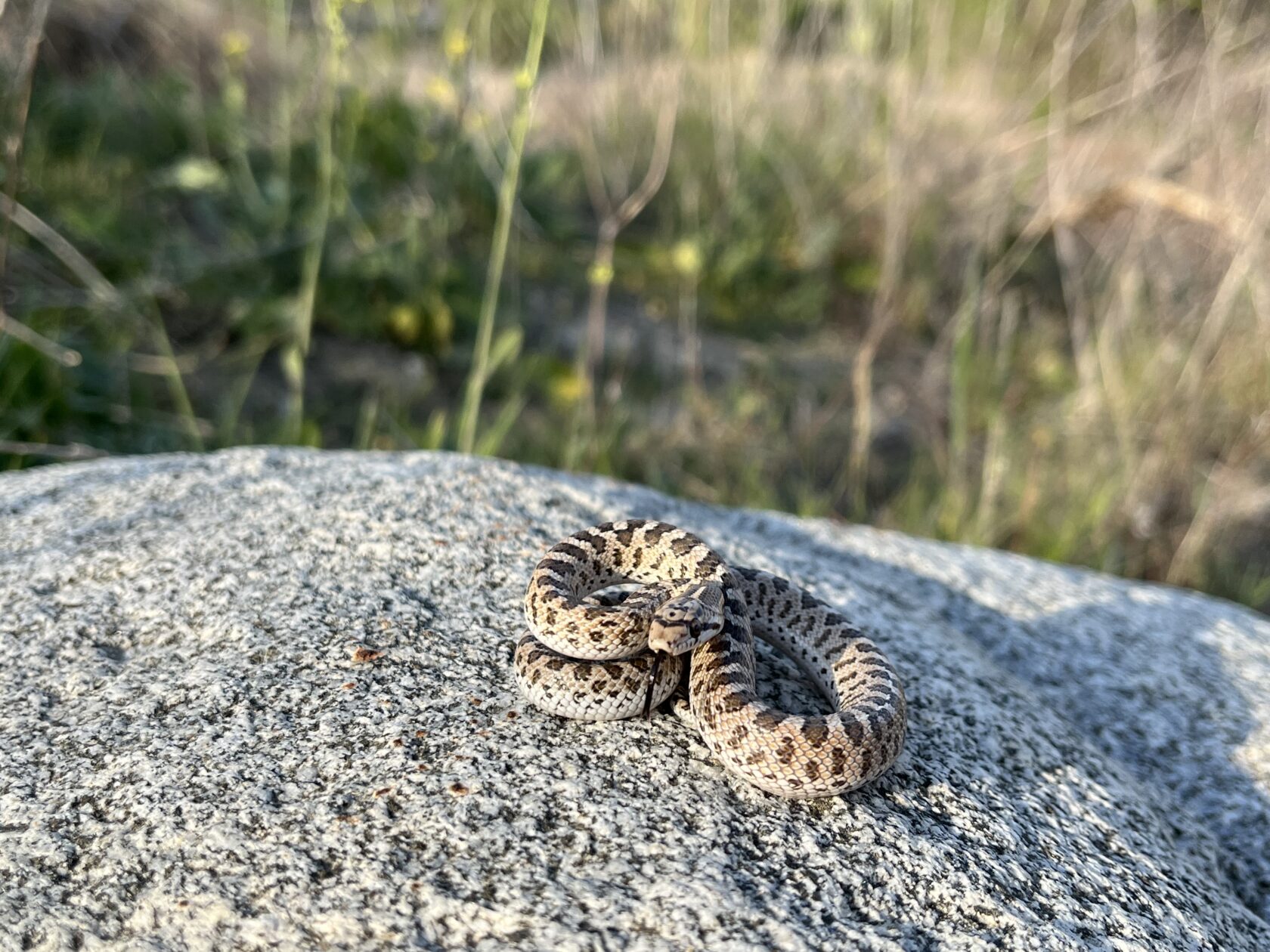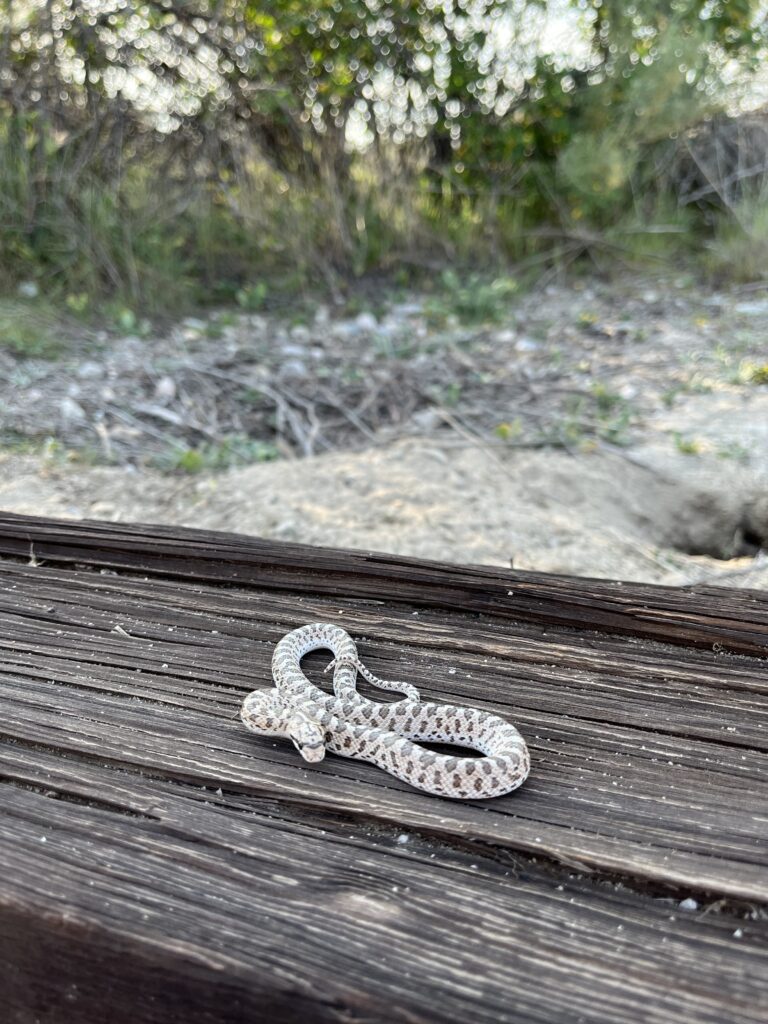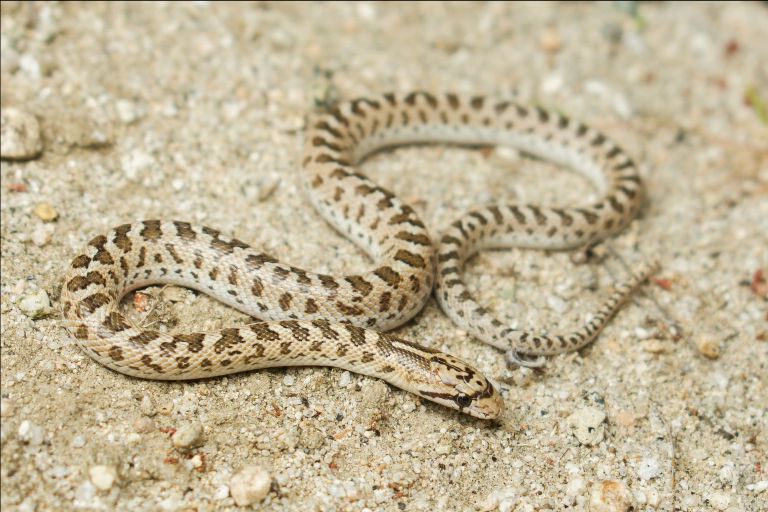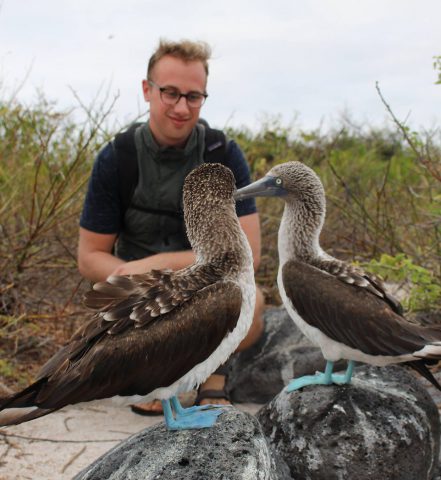
Finding the first Glossy Snake in the Los Angeles Basin in over 80 years
October 2022 | By Greg Nemes
This past March (2022), I made an unexpected discovery that sent shockwaves through the local USGS office when they heard the news. The culprit? A 9.9 inch snake that hadn’t been seen in the LA Basin since the 1930s. Here’s the story of the find and what’s happened since.
On March 4th, 2022, I went out for a hike at a park in Los Angeles. That time of year is still a bit slow for finding snakes, so I was looking but didn’t have high hopes of finding much. After an afternoon with only a Ringneck Snake that got away, I decided to call it quits. While heading back to the car, I found a nice looking railroad tie – the kind of thing you see and think to yourself “hmmm that looks good”. I flipped it and nearly missed the small, white and brown snake tucked under the back of the tie.

I’m fairly new to this region, and having only seen a few species out here, I’m relying on memory of reading field guides, looking at range maps, and looking at other people’s observations online. I figured the snake was a juvenile Gopher Snake (Pituophis catenifer), so I picked it up. I still felt it looked pretty different from a Gopher, so I was searching around online for something it could be. Nothing looked right except for a Glossy Snake, but they aren’t supposed to be found in this area. I decided to tentatively call it a really light Gopher Snake, so I texted my friend Zeev Sinai Nitzan Ginsburg, who knows a great deal more than I, and said “This is a gopher snake, right?” I enjoyed a few minutes with the gorgeous creature, snapped some photos, got the GPS coordinates, and let the snake go back under the tie.


I’m almost back at my car and Zeev calls to tell me it’s a California Glossy Snake (Arizona elegans occidentalis). He seemed pretty excited about it, so I was excited too! And I was surprised to have gotten a new lifer. I didn’t know just how surprised I should have been.
After talking to Zeev and my friend Chris DeGroof, and coordinating with the folks at USGS and the Natural History Museum, I was given instructions and permission to collect the snake for research purposes (it would be returned home very soon), as the government has been looking for this species in this area for many years.
Quick aside – while my California Fish and Wildlife permit would allow me to handle and collect some snake species in the state, the Glossy Snake is a protected species because of its imperiled status, meaning I was NOT supposed to have handled that snake to begin with 🤭. In this region, the only medically significant venomous species of snakes are all rattlers, so that’s the only reason I handled a snake I wasn’t 100% sure of the species. So please do not ever handle a snake you can’t identify, and be sure to learn which species are protected.
Okay so now I had to head back to the spot where I found the Glossy in the hopes it’s still there. Thankfully I had the GPS coordinates, because if you’ve ever tried to relocate a specific area in a scrubby desert area, you know it can be very tricky. I found the spot, held my breath, and flipped the railroad tie. I said (to no one) “hey, a California Glossy Snake”! I was a true expert in snakes now, as I could easily identify this species. But seriously, it was a relief and a thrill to have the snake in hand.
I carefully walked it back to my car, got it in a breathable container as per my instructions, and drove it to Chris’ house where someone from the feds would be picking it up later (they started their 2 hour journey as soon as they heard the news). I handed the snake over, and Chris could hardly believe his eyes. When I saw how big of a deal this was to him, one of the most experienced herpers I know, I started to get a sense of how special a find this snake was.

So here’s where it gets crazy. Someone from the government agency who was coming to pick up the snake sent a text: “First Glossy in the LA Basin since 1930s”. I couldn’t believe it – I probably said something stupid like “wow”, and thought something even more stupid which is “what is the LA basin”. The LA Basin (if I understand it correctly, which I probably don’t) is an area comprising several watersheds in the greater Los Angeles region. The basin is effectively comprised of the areas highlighted in the image below.

I’d be lying if I didn’t say it’s a bit embarrassing to have so spectacularly misidentified that snake. And to have accidentally handled a protected species. Oh, and to have texted an expert to basically say “I don’t know what I’m doing, right?” But this is what I find so interesting about hobbies that involve nature – amateurs have a naiveté that might lead them down a path others might avoid. We’re all constantly learning, and you can know so much and so little at the same time. Thankfully, the best of the experienced people are supportive and helpful – which is how this turned into a significant discovery that will hopefully benefit snakes and wildlife in this region.
Scientific Research on the Snake
The local United States Geological Survey office has been looking for Glossy Snakes in this area for a while now. They actually had a survey at this particular location, at which I volunteered last year. That’s how I knew about this particular spot. So there was a presumption this species could be here, but none had been found during the survey.
I brought the snake to my friend Chris’ house, and the USGS folks picked it up for some genetic research. Some of the genetic data is still being processed, but here’s what they’ve learned thus far:
- The snake was approximately 6 months old. Particularly exciting because it was likely born very nearby where it was found.
- Length 25.3 centimeters / 9.9 inches
- Weight 6.6 grams
- Sex Unknown
- The genetic sequencing they’re undertaking will help determine if this snake is related to an existing population, and if so which population.
There will be more data soon, and eventually a paper will be published with data on other anomalous California Glossy Snake finds in the Southern California region. Hopefully, this find and the science can keep this area protected and free of development. Fingers crossed!
I hope this story inspires you to explore your neighborhood patches and keep your eyes peeled for something unexpected.
I’ll leave you with some incredible photos from Andrew Louros of the USGS.



